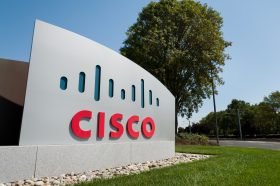Cisco Reinvents SDN, Market Yawns

Cisco (CSCO) on Tuesday announced a new plan to make its networking technology more programmable and software-driven, but does the market care? In San Francisco, the company gathered analysts, media, and customers at a glitzy marketing event (which I did not attend) to announce the "Biggest Innovation In the Past Decade." And then its share price... fell.
What was the great innovation? Cisco says it's making its networking technology more programmable and driven by analytics, a description of software-defined networking (SDN) trends that have been around for years. It announced the Cisco Digital Network Architecture (DNA), which appears to be a follow-on architecture to its prior Application Centric Infrastructure (ACI) initiative and the acquisition of startup Insieme -- the topic of another glitzy announcement in 2013. It made a claim that it is first in programmable, software-defined access technology -- which it is not. We'll talk more about the the technology and Cisco's claims later. But in the meantime, let's talk more about the market reaction.
I point to the stock price as a reference because that is the most objective thing I could think to gauge a reaction. It's notable when one of the world's largest technology companies unfurls a full day of superlatives, hype, and self-congratulatory marketing spew, including the "Biggest Innovation In the Past Decade," only to see its shares fall -- by 14 cents (-.44%) to $31.85.
Doesn't that say it all? Sure, the Nasdaq fell on Tuesday. But we're in the middle of a raging technology bull market. If Tesla (TSLA) or Amazon (AMZN) announced the "Biggest Innovation In the Past Decade," their share prices would go up by 10, 20, or even 30 percent. And if Apple did it you would see Apple shares up $50, it would follow with a five-for-1 reverse split, millionaires would be made overnight, and bloggers around the world would be falling over themselves trying to explain how Apple CEO Tim Cook had saved humanity.
Think of the armies of enlisted employees, the thousands (millions?) of dollars spent on marketing and PR consultants to secure the presentation venue, the speakers, the finger food, even bespoke fonts on the PowerPoints to present this great technological achievement. Only to see Cisco's share price fall.
What's it mean? A couple takeaways. 1) The market doesn't get that excited about networking technology anymore -- and if it does, it's focusing on rivals such as Arista Networks (ANET) who were talking about software-defined networking (SDN) a long time ago and are now taking share from Cisco. 2) The market wants Cisco to back up its claims with revenue growth and meaningful growth in share in the security market, neither of which it has demonstrated in recent years. The growth appears to be elsewhere -- cloud, big data, chip companies, security startups, etc.
On top of all this, Cisco's grandiose claims and vapid marketing language -- its marketing slides contained more buzzwords and adjectives than actual technology -- don't appear to jive with the reality of what's going on.
Let's break down what Cisco said in more detail. Here's a summary of what the company announced:
- A new networking architecture, the Cisco Digital Network Architecture (DNA) based on "intent," that is a network that can be programmed to automate what it needs to do to orchestrate and support applications. As Cisco puts it in the headline: "Cisco's new network can recognize intent, mitigate threats through encryption, and learn over time, unlocking opportunities."
- DNA Center: A new "intuitive, centralized management dashboard."
- Software-Defined Access (SD-Access). Technology that uses automated policy enforcement and network segmentation to simplify provisioning of access networks, such as wireless and broadband.
- Network Data Platform and Assurance. An analytics platform that "categorizes and correlates the vast amount of data running on the network and uses machine learning to turn it into predictive analytics."
- Encrypted Traffic Analytics. Cisco says its Talos software uses machine learning to analyze metadata of traffic patterns on encrypted traffic and can identify threats with 99 percent accuracy.
- Software Subscription. Cisco wants to sell the operating system and management software for its Catalyst 9000 switches by subscription.
- DNA Services. A portfolio of advisory and technical services.
- DevNet DNA Developer Center. Resources for developers.
Now, here's what's really going on -- and why most of this is not nearly as revolutionary as Cisco would like you to believe. Let's take a look at the claims and what's actually "new."
Intent-based networking. Cisco has introduced DNA to make its networking technology more programmable and automated. Great. But intent-based networking, an off-shoot of SDN, is nothing new. Arista has been focusing on the role of using analytics and a programmable OS for some time. And startup Apstra launched with the concept of intent-based networking. Where I used to work, SDxCentral.com, we published a lot of stuff about intent-based networking. Some of it was written in 2015. And almost none of it was written by Cisco employees.
DNA Center. Cisco's described this as an "intuitive, centralized management dashboard." In other words, Cisco has introduced a modern graphical user interface (GUI). This is an important move beyond its commonly known command-line interface (CLI). A new interface is sorely needed, but using a GUI to map networks is hardly revolutionary.
Software-Defined Access (SD-Access). Cisco tried to claim the "industry's first software-defined access" here. But access networking technology specialists such as Adtran and Calix have been working on SD-Access for a while. Calix announced the "world's only software-defined access platform" in July 2016, which you can read about here. Adtran announced its SD-Access product here. If you want to learn more, I wrote a blog about SD-Access for Adtran in April. The truth is that many companies have been working on SD-Access technology for years.
Network Data Platform and Assurance Analytics. I have not had time to delve into the details of Cisco's technology, but network monitoring and assurance analytics have been supplied by a rich group of third-party software vendors for some time. Some of the vendors that have innovated in this space include CA, CENX, Gigamon, HPE, Netscout, Infovista, and Spirent -- among others. SDN startups such as Big Switch and Pluribus Networks have also made analytics a big part of their story. This sounds like Cisco trying to bring more value of analytics in-house, but it's doubtful that Cisco will outrun the whole pack.
Encrypted Traffic Analytics. If it works, great. But Cisco's security claims seem so grandiose that they should be met with skepticism. As we noted in our recent security report, dozens of top startups as well as incumbent technology companies have been putting billions of dollars into security technology only to see some of the largest breaches in history. Security analysts say stopping hackers is a matter of time and money and can never be completely achieved. Cisco's grandiose claims of a 99 percent success rate in recognizing malicious encrypted traffic without being proven in production is therefore uncredible. We'll follow up on this later.
Software Subscription. This is a business strategy, not an innovation. And nothing about it is new.
Once again, Cisco has done something it does very well -- marketing. It has created a lot of noise about new trends in SDN -- many of them brought to the market earlier by competitors. It's good that Cisco is now focused on the software story of making networks more automated and programmable, and this will help move the market forward. But Cisco's over-the-top approach to these announcements, including misleading statements and the claims that it is innovating in areas in which other companies have innovated for years, sounds a little bit desperate.
And besides, in the end, the stock price went down.
Become a member. Check out Futuriom's premium analysis of technology's leading growth markets. Our latest premium report is the 50-page Ultimate Industrial Internet of Things (IIoT) Report, which covers a wide range of communications and cloud technologies that are being applied to businesses around the world to provide connectivity, analysis, automation, and optimization of a range of industrial applications. Use code "IIOT" to get a 15% discount.
















